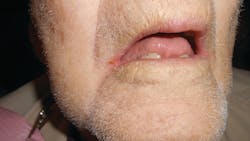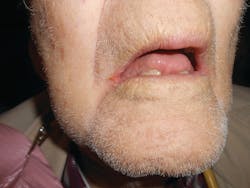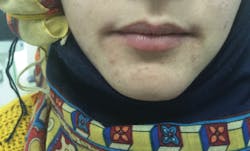The multiple etiologies of angular cheilitis
Editor's note: Originally published June 1, 2020. Formatting updated September 7, 2022.
Angular cheilitis is also known as perlèche, from the French word pourlécher, meaning to lick one’s lip.1 Sometimes, in various publications, angular cheilitis is referred to as angular stomatitis. The entity has been described for centuries, and for some individuals, the clinical characteristics may be described as chronic in nature. Reports have listed chronic health conditions such as diabetes, vitamin deficiency, and systemic diseases such as inflammatory bowel disease, Sjögren’s syndrome, xerostomia, and human immunodeficiency virus as known precursors.1
Angular cheilitis is characterized as an inflammatory condition that affects the commissures of the mouth, causing a break in the tissues with redness, crusting, and scaling. This is often compounded by the accumulation of saliva in the fissures (figure 1). Angular cheilitis can be an ongoing problem for some patients until the etiology is determined.
Several items have been cited as considerations in the diagnosis of angular cheilitis:
- Loss of vertical dimension as seen in elderly patients. The accumulation/pooling of saliva allows Candida albicans and Staphylococcus aureus to remain in affected fissures of the commissures. Perlèche is often found in edentulous patients due to noted loss of vertical dimension. There is also a decrease in dermal laxity. Clinicians usually report a scaly surface and sometimes a light white or orange color.
- Contact dermatitis originating from known compounds that a patient may be sensitive to such as dental products, lipstick, environmental substances promoting sensitivity, metals from dental appliances, etc., can be an indication.
- Sensitivity/allergic responses to environmental substances may also promote systemic effects such as xerostomia, tissue inflammation, and more extensive angular cheilitis.
- Iron-deficiency anemia—Patients with Plummer-Vinson syndrome may exhibit burning tongue, balding of the tongue (depapillation), redness, glossitis, shortness of breath, weakness, nail abnormalities, and dysphagia.
- Nutritional deficiencies account for 25% of all cases of angular cheilitis. This may be due to the deficiency in vitamins B2, B3, B6, and B12. Pernicious anemia is caused by a vitamin B12 deficiency.
- Cheilocandidiasis may exist in patients prone to oral habits such as lip-licking and chronic use of petrolatum-based salves and lip balms. These habits and products keep the tissues wet and allow development of candidiasis.2
Lichen planus pemphigoides: An autoimmune blistering disease
The uvula: An unnoticed appendage
A recent publication by Ayesh presents the case of a 20-year-old woman with a four-month history of red erosions around the mouth.1 After using an antifungal and antibacterial ointment, no relief was found. With hematologic testing, it was discovered that the patient had iron-deficiency anemia. Treatment with oral ferrous gluconate 300 mg twice daily proved to solve the cheilitis issues suffered by the patient. At a two-year follow-up appointment, the patient had no recurrence of angular cheilitis. The author hoped to call attention to the fact that iron deficiency may be a suspect factor for consideration in diagnosing chronic angular cheilitis (figures 2 and 3).
Treatment for angular cheilitis usually consists of antifungal agents such as nystatin cream or ointment applied daily for a predetermined time period. Cabras et al. reported success with 1% isoconazole nitrate (ISN) and 0.1% diflucortolone valerate (DFV) ointment.3 The ointment decreased inflammation and reduced species associated with angular cheilitis because of its broad-spectrum effect. The authors suggest more research is needed in this area for treatment and recommendations.3
In most cases, angular cheilitis is controlled with nystatin cream or ointment. However, sometimes the antifungal properties will allow bacterial colonies to increase, which promotes a more difficult type of inflammatory process (or the original contributing issues previously mentioned). At that time, a different treatment or a combination of treatments becomes necessary to control the inflammation. The combination of antibacterial and antifungal medications is one suggested method that may be effective as well.4 Other alternative and adjunct therapies include behavior modification to decrease drooling, photodynamic therapy, and occlusal vertical dimension restoration. Encouraging patients to seek treatment early for a definitive diagnosis is very beneficial, especially in chronic angular cheilitis cases.
As always, continue to ask good questions and listen to your patients.
References
- Ayesh MH. Angular cheilitis induced by iron deficiency anemia. Cleve Clin J Med. 2018;85(8):581-582. doi:10.3949/ccjm.85a.17109
- Neville BW, Damm DD, Allen CM, Chi AC. Oral and Maxillofacial Pathology. 4th ed. St. Louis, MO: Elsevier; 2016: 264-266.
- Cabras M, Gambino A, Broccoletti R, Lodi G, Arduino PG. Treatment of angular cheilitis: A narrative review and authors’ clinical experience. Oral Dis. 2019;00:1-9. doi:10.1111/odi.13183
- Hellstein JW, Marek CL. Candidiasis: Red and white manifestations in the oral cavity. Head Neck Pathol. 2019;13(1):25-32. doi:10.1007/s12105-019-01004-6
Additional resource
- DeLong L, Burkhart NW. General and Oral Pathology for the Dental Hygienist. 3rd ed. Baltimore, MD: Wolters Kluwer; 2019.
About the Author
Nancy W. Burkhart, EdD, MEd, BSDH, AAFAAOM
NANCY W. BURKHART, EdD, MEd, BSDH, AAFAAOM, is an adjunct professor in the Department of Periodontics-Stomatology, College of Dentistry, Texas A&M University, Dallas, Texas. She is founder and cohost of the International Oral Lichen Planus Support Group (dentistry.tamhsc.edu/olp/) and coauthor of General and Oral Pathology for the Dental Hygienist, now in its third edition. Dr. Burkhart is an academic affiliate fellow with the American Academy of Oral Medicine, where she also serves as chair of the Affiliate Fellowship Program Committee. She was awarded the Dental Professional of the Year in 2017 through the International Pemphigus and Pemphigoid Foundation, and she is a 2017 Sunstar/RDH Award of Distinction recipient. Her professional interests are in the areas of oral medicine and the relationship between oral and whole-body health, with a focus on mucosal disease and early oral cancer detection. Contact her at [email protected].




